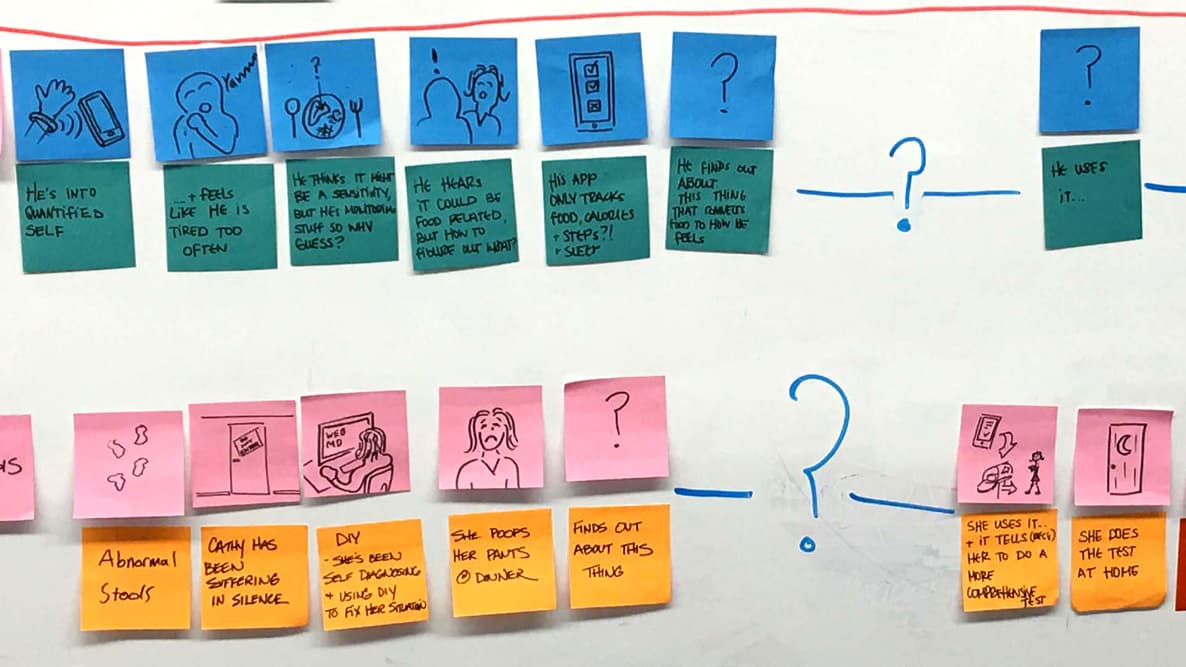Service Experience Jam: Designing cool service sh*$!
As part of a global weekend service experience challenge, we took the concept of quantified self to new intestinal territory.
Service Experience Jam: Designing cool service sh*$!
Last weekend, we gathered as a multidisciplinary team and headed to Chicago to attend the second annual Service Experience Jam.
We weren’t alone. In 40 locations around the world, from Hangzhou to Vancouver, Santiago to Helsinki, teams of service design practitioners and aficionados gathered over the weekend to prototype, learn and connect around a shared passion for designing experiences that work for people.
The Service Experience Jam headquarters surprised us all by this year’s secret theme. It was just a sound. How do you design a service around a sound? Each team was given the latitude to interpret the themes generated by the “sound” however they wanted with the goal of prototyping a service experience around said theme. Our Design Concepts team (not one to back down from a challenge) took the road least traveled and selected “poop” as our theme.
By the end of the weekend, what started out as a far-out theme started to feel more like a blue-sky opportunity. Huh, poop?! Hang with me for a sec…
Our Service Concept:
More than ever, people are embracing the behavior of the quantified self, using self-monitoring and self-sensing products to track inputs, states and performance. Most people, however, do not consider their “outputs” in the entire equation of health and wellness. Surprisingly, your poop can provide many key indicators about your overall well-being. These indicators can be as simple as nutrition but could also be indicators to larger health issues such as gastrointestinal disorders, autoimmune and inflammatory diseases, and mental health. Additionally, there is an increasing body of evidence that suggest food sensitivities are more common and have a wider and more varied impact on our health than previously realized. As our Scottish teammate noted, many European countries today do mandatory stool collection tests via mail, often after the age of 50, to test for colon cancer. But, as we learned, paying attention to your overall wellbeing shouldn’t start at 50.
What’s your poo telling you? Apparently it could be telling you more.
While there are existing services on the market for fecal collection and testing, there is no holistic service that looks at tracking and diagnostics that empowers the user in a way that is non-disruptive to their routine.
How might we create a service experience that leverages not just tracking our inputs (calories and nutrition) but also our outputs?
Here’s what we learned…
Don’t be everything to everyone.
We began by mapping various potential customer journeys. Cathy, who has suffered in silence from years of denying that she has a gastrointestinal problem. Walt, a marathoner who is trying to optimize his performance through personalized nutrition. Vera, who is volunteering for the Peace Corps and is concerned about getting sick while traveling. We could have kept going for days. But this was day two of the Jam and just hours remained.
There are various, significant user needs in this market. But we couldn’t design for everyone. In fact, your service will be stronger if you don’t design for everyone. Therefore, we decided to focus on Cathy and let her customer journey guide our first prototype.
Prototype experiences “onstage” to uncover the raw feelings and gut reactions.
The philosophy of service design is centered on theater so many of the tools begin with the idea of actors and audience, stage and props. Without any time for writing the script, we began recording an improvisational bodystorm. If you’re not familiar, bodystorming is a type of role playing that helps us quickly prototype experiences to gain empathy for users and inform a design. Literally within seconds of this exercise, we realized that it’s EXTREMELY EMBARRASSING to talk with another person about your bowel movements. This has to be a completely personal, private experience assisted by seamless digital touch points. Also, when we’re looking at diagnostics, mailing someone a box of your poop is not okay. The collection method not only has to be touchless but also discrete.
It’s about an experience over time, not just a thing.
It’s easy for a team of designers to zero-in on the tangible product or thing — in this case the stool collection kit. Early on, it seemed like the most critical piece to making this entire experience work. However, in service design it’s more important to understand how the personality of your service comes to life across touchpoints — physical and digital, tangible and intangible. It’s all about creating a seamless experience across media. Instead, we created a low-fidelity prototype of our service experience — from need to solution, complete with low-fidelity props— to help us define what that experience should look and feel like.
The result is Backstory. A service that helps people learn the story their poop is telling them through integrated daily tracking, easy annual diagnostics and professional support services. Over the course of the weekend, we used service design methods to map a holistic experience for the customer and for the business.
Don’t be afraid to go there.
We came away from the Service Experience Jam inspired by the connections we made and the amount we produced in just 48 hours. More importantly, it highlighted the significant role service design can play in demystifying the culturally taboo — beyond just poop to things as critical as Ebola treatments, vaccinations and sex education. As designers, we can’t be afraid to go there.
To see a video of our one-take, low-fidelity prototype, click the photo below. Thanks to Sherry Eckholm for contributing to this article.
